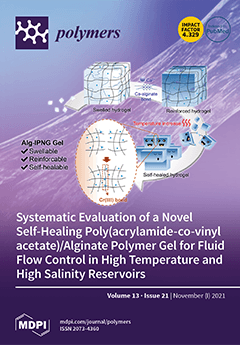Inorganic biopolymer-based nanocomposites are useful for stabilizing lipases for enhanced catalytic performance and easy separation. Herein, we report the operational stability, regenerability, and thermodynamics studies of the ternary biogenic silica/magnetite/graphene oxide nanocomposite (SiO
2/Fe
3O
4/GO) as a support for
[...] Read more.
Inorganic biopolymer-based nanocomposites are useful for stabilizing lipases for enhanced catalytic performance and easy separation. Herein, we report the operational stability, regenerability, and thermodynamics studies of the ternary biogenic silica/magnetite/graphene oxide nanocomposite (SiO
2/Fe
3O
4/GO) as a support for
Candida rugosa lipase (CRL). The X-ray photoelectron spectroscopy (XPS), X-ray diffraction (XRD), field-electron scanning electron microscopy (FESEM), vibrating sample magnetometry (VSM), and nitrogen adsorption/desorption data on the support and biocatalyst corroborated their successful fabrication. XPS revealed the Fe
3O
4 adopted Fe
2+ and Fe
3+ oxidation states, while XRD data of GO yielded a peak at 2θ = 11.67°, with the SiO
2/Fe
3O
4/GO revealing a high surface area (≈261 m
2/g). The fourier transform infrared (FTIR) spectra affirmed the successful fabricated supports and catalyst. The half-life and thermodynamic parameters of the superparamagnetic immobilized CRL (CRL/SiO
2/Fe
3O
4/GO) improved over the free CRL. The microwave-regenerated CRL/SiO
2/Fe
3O
4/GO (≈82%) exhibited higher catalytic activity than ultrasonic-regenerated (≈71%) ones. Lower activation (
and higher deactivation energies (
were also noted for the CRL/SiO
2/Fe
3O
4/GO (13.87 kJ/mol, 32.32 kJ/mol) than free CRL (15.26 kJ/mol, 27.60 kJ/mol). A peak at 4.28 min in the gas chromatograph-flame ionization detection (GC-FID) chromatogram of the purified ethyl valerate supported the unique six types of 14 hydrogen atoms of the ester (CAS: 539-82-2) in the proton nuclear magnetic resonance (
1H-NMR) data. The results collectively demonstrated the suitability of SiO
2/Fe
3O
4/GO in stabilizing CRL for improved operational stability and thermodynamics and permitted biocatalyst regenerability.
Full article






